The Master of the Nets Garden
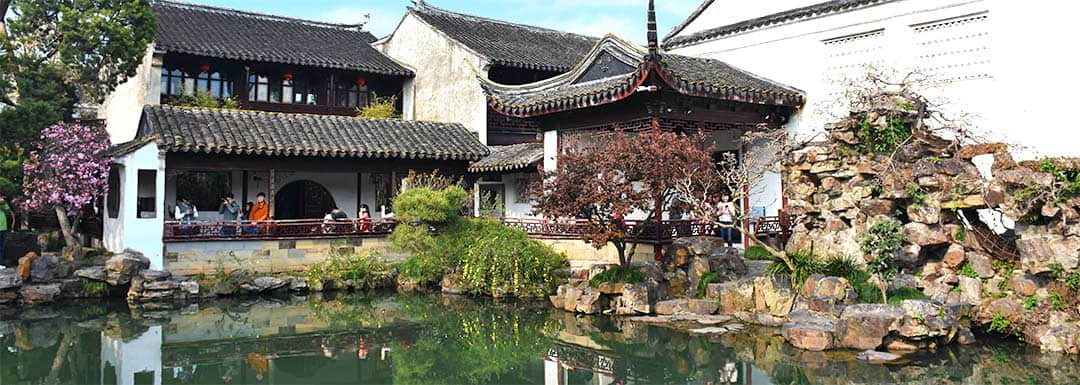
The Master of the Nets Garden, a pocket-sized but elegant garden, perfectly preserved the residential garden landscape of the traditional Suzhou families. As the epitome of “less is more”, it represents the best of Suzhou gardens, and has been praised as “the smallest but most delicate garden”. It was recognized as the World Cultural Heritage by UNESCO, a National AAAA Scenic Spot, a historical & cultural relic under state protection, and one of four most famous gardens in Suzhou. The garden is like “a great recluse hiding in the street, or a small recluse hiding in the alley”, silently concealing itself in a cross alley in Shiquan Street, Suzhou. Like a young lady hidden in her boudoir, she exudes the demure temperament of this southern China water town.
- Chinese name: 网 师 园 Wǎng Shī Yúan
- Constructed in: 1174 A.D.
- Duration: 1 hour
- Opening hours:
1st Jan – 31st Mar 7:30 am - 5:00 pm;
1st Apr – 31st May 7:00 am - 5:30 pm;
1st Jun – 30th Jul 7:30 am - 5:00 pm;
1st Jul – 31st Oct 7:00 am - 5:30 pm;
1st Nov – 31st Dec 7:30 am - 5:00 pm;
Night Tours in the Garden: 1st Apr, 2018 – 31st Oct, 2018 7:30 pm – 10:00 pm
Tickets check starts at 7:20 pm and ends at 9:10 pm. - Entrance fee: RMB 40 (peak season) RMB 30 (off season) RMB 100 (night tour)
- Best time to visit: All year round
- Address: No.11 Kuojiatou Alley, Daicheng Bridge Road, Gusu District, Suzhou, Jiangsu
- How to get there:Bus No.55, No.811, No.529, No.202, and No.931
Highlights of the garden
The Late Spring Study (Dian Chun Yi)
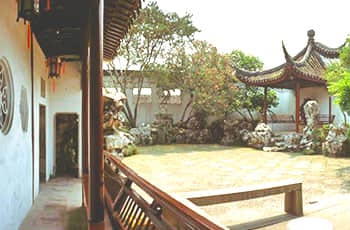
The Late Spring Study (Dian Chun Yi)
“Dian Chun” means late spring, and “Yi” usually refers to a small room beside a pavilion. The room used to be a study with a courtyard, and the courtyard was planted all over with peonies. In late spring, with the blooming peonies, the study turns into a tourist attraction, thus gaining the name the “Late Spring Study”. The study has been used as a prototype for the Ming Hall Garden at the Metropolitan Museum of Art in New York City.
The Sedan Chair Hall
The Sedan Chair Hall is where the owner and the guests park their sedan chairs. The inscribed board hanging on the hall reads “Rectitude Leads to Success”. The feudal dynasties in China held up uprightness and competency as the standards for bureaucratic success.
The Hall of Scrolls
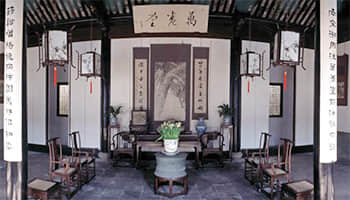
The Hall of Scrolls
The main hall is always the central theme of a garden. It used to be where the garden owner handled affairs and received the guests, and is usually ornately decorated and furnished. The name of the hall means to “collect a million scrolls of books”.
The Chamber of Qin
This is where the garden owner plays the instrument Guqin. It is a fully enclosed space. The southern wall of the courtyard is a steep and towering embedded mountain. According to legends, it was built by famous Qing-dynasty landscape artist Ge Yuliang. The chamber is a saddle-roof half-pavilion. Facing the green mountain, lighting a pot of incense, and playing the tune “Lofty Mountains and Flowing Water”, one can never find a better place to practice the ancient instrument Guqin.
The Five Peaks Study
On both the front and the back of the study are courtyards with decorative rockeries. The rockery in the front yard is a miniature of the Five Old Peaks on Lushan Mountain. The study is where the garden owner collects and reads books.
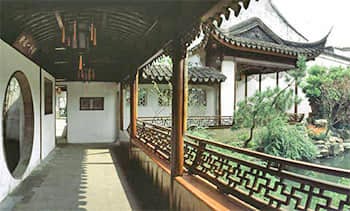
A Branch Beyond Bamboo Porch
The Pureness Study
The name comes from a line in Zhaungzi |On the Mundane World: “Enlightenment requires pureness of mind. Pureness is the study room for the mind.” This means that people should purge their distracting thoughts to keep their mind clear and pure. The study is the garden owner’s spiritual retreat and reading room.
A Branch Beyond Bamboo Porch
This is a spring attraction. The name comes from Song-dynasty poet Su Shi’s poem “There are thousands of shady trees in spring beside the river. A branch of prunus mume beyond the bamboo looks even better.”
The Watching Pines and Contemplating Paintings Studio
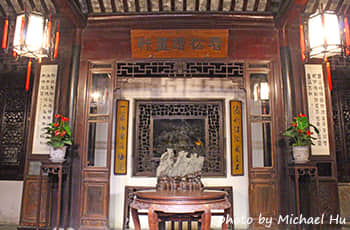
This is the main room, and also the winter attraction of the garden. In the southern court stands an ancient cypress tree left from a time when the Studio was still part of the Hall of Scrolls. It is the oldest and tallest tree in the garden. The treetop has already withered, but the medial and lateral branches hanging on the main trunk are still dark green. Other trees in the courtyard are Podocarpus macrophyllus, black pines, and white bark pines, all century-old ancient trees. Confucius once said: “Only in cold winter does one know that the pine and the cypress are the last to shed their leaves”. In severe winter, all trees have withered, only the pine and the cypress are evergreen. In this particular season, you can keenly feel their spirit. The “Contemplating Paintings” part in the name means that in winter, when the evergreens stand alone in the courtyard, you can contemplate this picturesque scene and appreciate their verve.
The Moon Comes with Breeze Pavilion
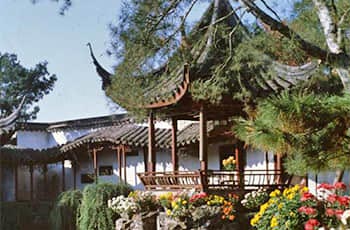
The Moon Comes with Breeze Pavilion
The pavilion is located inside the western part of the Rosy Clouds Pool. It has a hexagon pyramid roof, and is surrounded by water on three sides. The diameter of the pavilion is 3.5 meters and its height is 5 meters. The roof is covered with black tiles, with a green-brick rooftop. The eaves fly up high into the sky, and the roof has very smooth outlines. The name comes from the Song-dynasty poet Shao Yong’s line “When the moon moves into the center of the sky, the breeze gently caresses the surface of the water”. Inside the pavilion there are several “Goose Neck Pillows” on the bench. Visitors can sit here and take a rest, appreciating the beauty of the moon in the cool breeze.
The Ribbon Washing Pavilion over Water
This is a summer attraction. Sitting on the south and facing northward, and with a saddle round-ridge roof, the water pavilion is small and delicate. As it’s built on water, the space inside the pavilion is cool and pleasant. Visitors can lean on the handrails to watch the fish and lotus flowers.
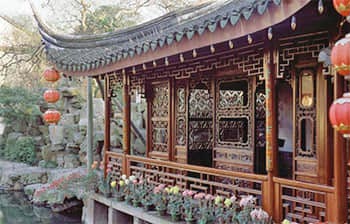
The Ribbon Washing Pavilion over Water
The Cloud Rockery
The Cloud Rockery is built of yellow stones. A stone path winds around it, and at the back there are steps for ascending the mountain. Green maples and magnolia trees are planted on the mountain.
The Cloud Staircase Chamber
The name comes from a story in Tang-dynasty scholar Zhang Du’s Xuan Chamber Records. The story recorded a young man named Zhou Sheng using a rope as a staircase and taking the moon from among the clouds. The rockeries in the front courtyard are built with the stone-piling technique called “Painting the Clouds”. The main peak of the rockery is actually the east peak of the Five Peak Study. The rockery has been built alongside the house, forming a house-mountain complex. People can ascend the mountain path to enter the house.
The House of Harmony
The name comes from a line in The Book of Changes: “Treasure Peace and Harmony”. The room is quiet and elegant. It used to be the place where the garden owner entertained his guests.
The House of Picking Beautiful Scenery
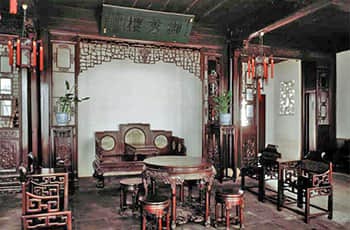
The House of Picking Beautiful Scenery
“Picking Beautiful Scenery” means to collect the beautiful scenes like picking flowers. This is the back hall of the residential area, also called the female hall. The garden owner mainly used it as a living room and a place to meet the guests.
The Little Hill and Osmanthus Grove Pavilion
This is an autumn attraction. The name comes from the “Songs of Chu: The Little Hill Beckons the Recluse:” Groves of sweet-scented Osmanthus Fragrans grow on the mountaintop. On the south there is a Taihu Stone Rockery; on the north is the main peak of the yellow-stone Cloud Rockery. One is delicate, the other is simple. The two rockeries form a deep and secluded valley in between, and many sweet-scented Osmanthus Fragrans trees are planted along it. In autumn, when Osmanthus flowers are in full bloom, the rich and refined fragrance of the flowers will gather in the valley and linger for a long time.
Drop us a line and we'll connect you with the top China expert in no time!